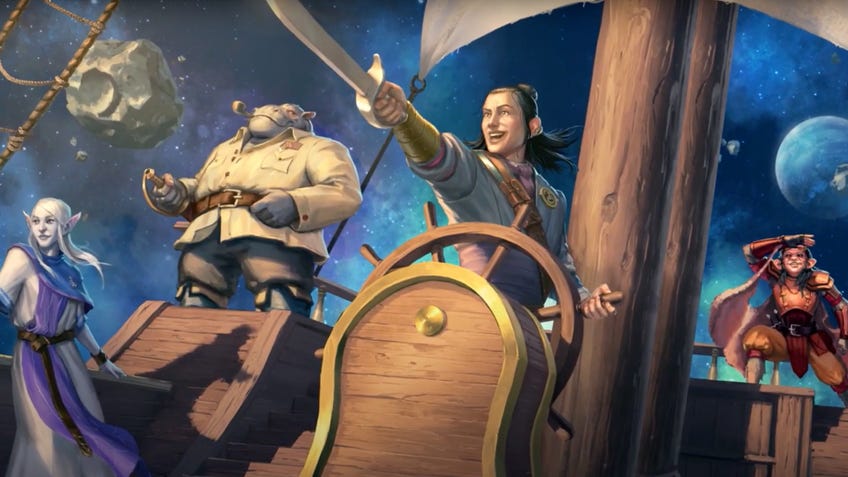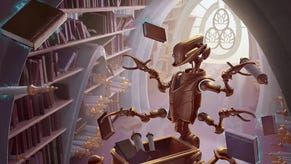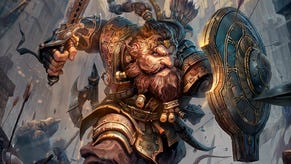‘We wanted Star Trek in D&D’: Spelljammer creator Jeff Grubb on the origins of the cult-classic setting
As Adventures in Space returns for 5E.
When Jeff Grubb was in college, he had a poster of Rodney Matthews’ Ice Schooner hanging on his wall. It’s an impressive illustration, showing a huge, chrome galleon gliding through a polar landscape. Grids of pinpoint lights decorate its hull, while icy monoliths loom overhead. Its clipped sails are unfurled, but it’s not just the wind that’s pushing the ship forwards. Pairs of enormous, protruding ice skates run the length of the vessel, slicing a path through the frozen lake beneath.
Much of Spelljammer - the cult-classic space-based Dungeons & Dragons setting that was recently rebooted for Fifth Edition - is captured in that single image. A familiar ship is removed from its natural setting, outfitted with otherworldly apparatus, and sent to sail through an unknown landscape. For Grubb, the writer and designer of the original 1989 Spelljammer boxed set, the Ice Schooner was the setting’s first point of inspiration, but hardly its last.
“The idea was to be able to play Star Trek in AD&D,” Grubb says. “It came out of a brainstorming session at a local restaurant. We were throwing ideas around and I pitched this concept: a knight standing on the deck of a ship in space. He can breathe, he’s not floating away, and there’s gravity - but he’s not wearing a space suit,”
Even that barebones concept marked a significant departure from D&D’s usual stomping ground. Up to that point, the roleplaying game’s campaign settings had largely spanned different subgenres of fantasy. Greyhawk’s low-magic world was followed up by the high fantasy of Mystara. Ravenloft injected elements of gothic horror, the Forgotten Realms offered a Tolkienesque world and Dragonlance leant into heroic fantasy.
We were basically trying different flavours of fantasy and Spelljammer took us somewhere we had not been before.
“I wanted to push the envelope,” says Grubb. “We were basically trying different flavours of fantasy and Spelljammer took us somewhere we had not been before. This was an opportunity to get out there and do something that was visually very wild compared to what our other worlds were doing.”
Not that this was the first time D&D had melded with science fiction. Spaceships and futuristic technology were introduced in the 1977 module Expedition to the Barrier Peaks. Taking players through a crashed spaceship on Greyhawk, the adventure had them meet malfunctioning androids, battle laser-wielding Mind Flayers and encounter alien weaponry.

But Spelljammer went further, not only sending D&D to space but outlining the game’s preliminary cosmology. Greyhawk, Dragonlance and other previously disparate D&D campaign settings were connected through a cosmic structure that riffed on medieval astronomical theories. Each setting was placed within an area of local space called a Crystal Sphere, which were themselves strung across a wider cosmic sea known as the phlogiston. “It was a meta-system like Planescape was later,” says Grubb. ”The idea was to be able to move between worlds easily, but keep the coherency and authenticity of the worlds themselves.”
That meta-system marked a massive expansion to D&D lore, but also intimately influenced Spelljammer’s final form. The campaign settings that Grubb was tasked with connecting all sat firmly in the Western tradition of medieval fantasy, making them incompatible with faster-than-light spaceships, rayguns and other popular sci-fi tropes of the day. The upshot was that Spelljammer would not only be D&D’s first fully-fledged space setting, but a fantasy-space setting more grounded in alchemy than empiricism.
“There’s a lot of science that we could explain in magical terms - holodecks versus illusions, for example,” says Grubb. “Plus, a lot of the cultures that we were dealing with were in the same medieval stage, like Greyhawk and Forgotten Realms. You’re not seeing a huge tech difference between them, and we never introduced a superior [civilisation].”

Despite that rejection of familiar science-fiction aesthetics, Spelljammer pulled liberally from late ‘80s pop culture - a time when distinctive spaceship designs were very much in vogue. Star Wars, Star Trek and pulpy space operas like Battle Beyond the Stars showed that entire galactic factions could be recognised by their starships. Just as cinema audiences came to know the Rebel Alliance by its X-Wing fighters, Spelljammer distinguished its spacefaring peoples by their interstellar vehicles.
Humans commanded fantastical versions of ordinary boats, like the Ice Schooner of Grubb’s college days. Dwarfs piloted lumbering space rocks, while Mind Flayers steered shell-shaped nautiloids.“I brought that in fairly early because I wanted to give a different vibe to each of the different peoples of space,” says Grubb. “The Elven Armada tends to be made of butterfly ships, while the Giff [Spelljammer’s faction of humanoid hippofolk] ships are built around a big gun at the front. Different cultures have different varieties, and it helps solidify the identity of the various peoples out in space.”
Those ships have become a hallmark of the setting. Their outlandish looks have scarcely been matched by other D&D worlds since, and their almost psychedelic designs speak to the creative freedom that Grubb enjoyed on the project. With no licence restrictions or plans for spin-off books and comics to work around, Grubb could populate the void of space with whatever strange ideas he and artist Jim Holloway thought up.
“I would ask Jim to give me a ship that looks like a butterfly, a squid or a hammerhead shark,” says Grubb. “He would come back with all of these various designs, and we’d turn to [Spelljammer cartographer] Dave LaForce to do the deck plans.”
The Space Hamsters came out of an offhand comment. Someone asked, ‘What's in the wheels of the gnome ship?’ I said, ‘Oh, those are for hamsters.’
Each one had to be designed in accordance with Spelljammer’s rules for gravity planes - Grubb’s pseudo-scientific explanation for how characters could stay planted on a ship’s open deck while drifting around space. “I think the ship designs are one of the attractions of Spelljammer,” he says. “Getting these very wild, very different ships and being able to utilise them in space combat.”
For a D&D setting as open-ended as Spelljammer, there was no limit to diversity or absurdity. Anthropomorphic, gun-toting hippos look right at home in the vastness of space, and anything can be explained away when you’re working off a blank slate. When Holloway created five Beholder ships, Grubb didn’t need to narrow them down to one, but could add all of them to the game, retroactively explaining their distinctions through the lore. When a gnome ship was designed with peculiar side wheels and no obvious propulsion system, he could invent the most absurd explanation possible.
“The Space Hamsters came out of an offhand comment,” says Grubb. “The gnome ship’s front half is a small wooden ship and the back half is a liner. But in the middle, they've got two side wheels. Someone asked, ‘What's in the wheels?’ I said, ‘Oh, those are for hamsters.’ Roger Moore, editor of Dragon [D&D’s official accompanying magazine at the time], thought that was hilarious, so we did a full write-up for the Monster Manual on all the different varieties of Space Hamsters. It just took off from there.”

In the end, Spelljammer’s scope fed into its tonal breadth. While furry rodents could be found cavorting on one side of the universe, the Neogi - horrifying eel-spider hybrids that command slave-driven deathspider ships - added an element of cosmic horror to another. The genocidal Unhuman Wars fought between the Elves and orcish Scro, meanwhile, were added to introduce an element of intergalactic politicking for sterner adventurers to navigate.
Like all lasting tabletop roleplaying settings, Spelljammer handed players an expansive world to interpret for themselves. The familiar landscapes of D&D’s previous campaign settings were there, but connected and punctuated by astronomical oddities. Sending D&D to space wasn’t so much a giant leap as it was a small step from everything that came before.
“It basically made D&D appealing to both a core group and a new group that might shy away from standard fantasy,” says Grubb. “I think it was a natural evolution.”










